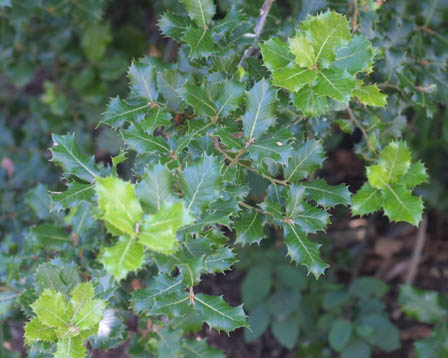
Quercus semecarpifolia (Kharsu)
Quercus semecarpifolia, commonly known as Kharsu oak, is a dominant and ecologically vital tree species found in the subalpine and temperate forests of the Great Himalayan National Park (GHNP). Known for its robust form and dense foliage, Kharsu oak plays a foundational role in sustaining biodiversity at higher elevations.
Distribution in the Great Himalayan National Park
In GHNP, Kharsu oak is typically found at elevations ranging from 2,500 to 3,300 meters, forming dense, evergreen forests on north-facing slopes. These forests are most prevalent in:
-
Tirthan Valley
-
Sainj Valley
-
Rolla–Shilt trail and parts of Rakhundi top
Botanical Features
-
Height: Can grow up to 25 meters tall
-
Leaves: Thick, leathery, and serrated with a dark green upper surface
-
Bark: Dark and deeply fissured
-
Acorns: Produced singly or in clusters; serve as food for birds and mammals
This species remains evergreen year-round and provides vital canopy cover and microhabitats.
Ecological Significance
The Kharsu oak forests are crucial for:
-
Preventing soil erosion on steep mountain slopes
-
Serving as wildlife habitat for species like the Himalayan black bear, musk deer, and numerous bird species such as the koklass pheasant
-
Acting as a carbon sink and regulating local microclimates
Its leaves also provide high-quality fodder for herbivores.
| Local name | Kharsu oak |
| Botanical name | Quercus semecarpifolia |
| Family | Fagaceae |
| Description | It is a tree having young shoots tomentose. Leaves usually entire, brown or rusty tomentose beneath, lateral nerves forked. Scales of acorn imbricate. It is found at an altitude of 2100-3500m above all oaks. |
| Flowers and Fruits | April – May |
| Distribution | It is commonly found in temperate and sub-alpine forests, in Tirthan and Sainj valley |
Cultural and Traditional Uses
Local communities in the Himachal region value Kharsu for:
-
Timber and fuelwood (though felling is now restricted in protected zones)
-
Fodder leaves during winter months
-
Traditional medicine, where bark extracts are sometimes used for treating fevers and wounds
Conservation Importance
Despite its resilience, Quercus semecarpifolia faces threats from:
-
Overgrazing
-
Lopping for fodder
-
Climate change, which shifts the tree line upward and fragments habitats
The Great Himalayan National Park, being a UNESCO World Heritage Site, offers these ancient oak forests a protected environment crucial for their long-term survival.



